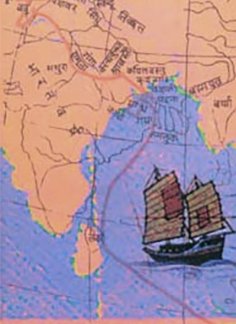Cankam, Caṅkam, Cāṅkam: 4 definitions
Introduction:
Cankam means something in the history of ancient India, biology, Tamil. If you want to know the exact meaning, history, etymology or English translation of this term then check out the descriptions on this page. Add your comment or reference to a book if you want to contribute to this summary article.
India history and geography
Source: Shodhganga: The significance of the mūla-beras (history)Caṅkam is another name for Saṅgam literature is aptly regarded as the crown of Tamil literature. The ancient works, Pattupāṭṭu (a collection of ten ancient Tamil poems) and Eṭṭutokai (the eight anthologies of the Caṅkam period) give details about the art of dance in the Caṅkam period. Caṅkam (Saṅgam) literature informs that Ātimanti, daughter of King Karikāla and a noteworthy queen in the Chola kingdom; Āṭṭanatti, a chieftain of Chera dynasty and Āṭukoṭpāṭṭu Ceralātan, a king, were experts in the art of dance. Caṅkam literature provides the information that the members of the royal family, along with the poets, practised the art of dancing.

The history of India traces the identification of countries, villages, towns and other regions of India, as well as mythology, zoology, royal dynasties, rulers, tribes, local festivities and traditions and regional languages. Ancient India enjoyed religious freedom and encourages the path of Dharma, a concept common to Buddhism, Hinduism, and Jainism.
Biology (plants and animals)
Source: Wisdom Library: Local Names of Plants and DrugsCankam [சாங்கம்] in the Tamil language is the name of a plant identified with Tinospora cordifolia from the Menispermaceae (Moonseed) family. For the possible medicinal usage of cankam, you can check this page for potential sources and references, although be aware that any some or none of the side-effects may not be mentioned here, wether they be harmful or beneficial to health.
Source: Google Books: CRC World Dictionary (Regional names)1) Cankam in India is the name of a plant defined with Azima tetracantha in various botanical sources. This page contains potential references in Ayurveda, modern medicine, and other folk traditions or local practices It has the synonym Monetia barlerioides L’Hér. (among others).
2) Cankam is also identified with Tylophora asthmatica It has the synonym Asclepias vomitoria (Lam.) J. König ex Hook. f. (etc.).
Example references for further research on medicinal uses or toxicity (see latin names for full list):
· Botanische Jahrbücher für Systematik, Pflanzengeschichte und Pflanzengeographie (1894)
· Journal of Ethnopharmacology (1997)
· Journal of Ethnopharmacology (2007)
· South African Journal of Science (2001)
· Supplementum Plantarum (1781)
· Annals of the East Cape Museums (2000)
If you are looking for specific details regarding Cankam, for example chemical composition, extract dosage, diet and recipes, health benefits, pregnancy safety, side effects, have a look at these references.

This sections includes definitions from the five kingdoms of living things: Animals, Plants, Fungi, Protists and Monera. It will include both the official binomial nomenclature (scientific names usually in Latin) as well as regional spellings and variants.
See also (Relevant definitions)
Starts with (+6): Camkamira, Camkamiya, Camkamma, Camkammana, Camkammia, Canka-mataipalli, Cankam kuppi, Cankam ver, Cankama, Cankama Sutta, Cankamadayaka, Cankamalinkam, Cankamam, Cankamana, Cankamanta, Cankamanti, Cankamar, Cankamati, Cankami, Cankamika.
Ends with (+37): Acankam, Aciriticankam, Aikkiya-nanavacankam, Akacapancankam, Alocanaiccankam, Apacankam, Aracankam, Arucankam, Atikappiracankam, Atipaticcankam, Atippiracankam, Carcankam, Cata-koticankam, Catucankam, Cavicankam, Cen-ciluvaicankam, Cittantapancankam, Iracankam, Kacankam, Kaccankam.
Full-text (+133): Cankam ver, Cankam kuppi, Narcankam, Cankamilar, Tayccankam, Vallai, Viraliyatal, Tutitunkal, Tuti-atal, Verikkuttu, Alocanaiccankam, Aruvai-atal, Valamalai, Kotiyar, Kilaiccankam, Kayiratal, Vallai-kuttu, Kalalnilai, Ariyakkuttu, Cankamvanki.
Relevant text
Search found 4 books and stories containing Cankam, Caṅkam, Cāṅkam; (plurals include: Cankams, Caṅkams, Cāṅkams). You can also click to the full overview containing English textual excerpts. Below are direct links for the most relevant articles:
The Religion and Philosophy of Tevaram (Thevaram) (by M. A. Dorai Rangaswamy)
Nayanar 40: Poyyatimai illata pulavar < [Volume 4.1.1 - A comparative study of the Shaivite saints the Thiruthondathogai]
Nayanar 49: Kari < [Volume 4.1.1 - A comparative study of the Shaivite saints the Thiruthondathogai]
Nayanar 9: Yenathinathar (Enatinata) < [Volume 4.1.1 - A comparative study of the Shaivite saints the Thiruthondathogai]
Annadatri-carita (study) (by Sarannya V.)
5. The Grand feast in Sangam Literature < [Chapter 1 - The Myth of Grand Feast]
1. The Chera Dynasty (Introducion) < [Chapter 2 - Depiction of King Utiyan Ceralatan in History and Literature]
Hindu Pluralism (by Elaine M. Fisher)
The Śivalīlārṇava of Nīlakaṇṭha Dīkṣita < [Chapter 4 - The Language Games of Śiva]
Twin Texts: The Canonization of the Tiruviḷaiyāṭal Purāṇam < [Chapter 4 - The Language Games of Śiva]
Tiruvaymoli (Thiruvaimozhi): English translation (by S. Satyamurthi Ayyangar)
Pasuram 4.3.6 < [Section 3 - Third Tiruvaymoli (Kovai Vayal)]
Pasuram 6.4.9 < [Section 4 - Fourth Tiruvaymoli (Kuravai aycciyarotu)]
Pasuram 8.2.1 < [Section 2 - Second Tiruvaymoli (Nankal varivalai)]